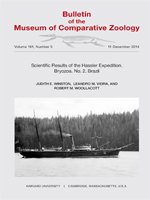Fifty species of bryozoans from three Brazilian stations dredged by L. Agassiz and L. F. Pourtalès during the Hassler Expedition (1871–1872) are described and illustrated here.
The U.S.S. Hassler was built in New Jersey for use by the U.S. Coast Survey off the west coast of North America. Benjamin Peirce, then superintendent of the Survey, invited L. Agassiz to form a scientific party to collect specimens and make scientific observations during the course of repositioning the Hassler from Boston to San Francisco. The bryozoan samples were discovered in the Invertebrate Paleontology collection at the Museum of Comparative Zoology and are now incorporated into the collections of the Department of Marine Invertebrates of the Museum of Comparative Zoology, Harvard University. The first paper on the collection, consisting of the bryozoan material from Barbados, was published in 2009 (Winston and Woollacott 2009).
Taxonomic results from the Brazilian segment of the expedition include 24 new cheilostome species, Antropora hastata, Retevirgula multipunctata, Parellisina lunatirostris, Discoporella salvadorensis, Canda alsia, Micropora angustiscapulis, Floridina proterva, Labioporella tuberculata, Cellaria brasiliensis, Puellina octospinosa, Trypostega tropicalis, Poricella frigorosa, Exochella frigidula, Metrarabdotos jani, Parasmittina simpulata, Parasmittina loxoides, Stylopoma rotundum, Stylopoma carioca, Fenestrulina constellata, Buffonellaria variavicularis, Turbicellepora brasiliensis, Fodinella atlantica, Plesiocleidochasma foliosum, and Cigclisula tuberculata; one new combination; and three new cyclostome species, Plagioecia bugei, Nevianopora arcuata, and Disporella brasiliana. Two new families, Marcusadoreidae and Vitrimurellidae, and one new genus, Vitrimurella, are also described.
The bryozoan material comes from three of the Brazilian locations where the Hassler Expedition dredged. Eleven species were collected from a station north of Salvador, Bahia state, in 15–17 fathoms (fms) (27.4–31 m). The other two stations were both off Cabo Frio, Rio de Janeiro state. Eleven species were found in the dredge haul from 35 fms (56.7 m), while 32 species occurred in the second haul from 35–45 fms (56.7–82 m). Species from the Bahia station have more tropical affinities; those collected from off Cabo Frio are subtropical–temperate. There was no overlap between the stations from the two regions. Most striking is the fact that 142 years after the collections were made, and on the basis of this very limited material, more than half the species found were new to science, or were species that had previously been misidentified, so needed new names and descriptions: Canda alsia, Labioporella tuberculata, Metrarabdotos jani, Nevianipora arcuata, Parasmittina loxoides, Parasmittina simpulata, and Plagioecia bugei.





